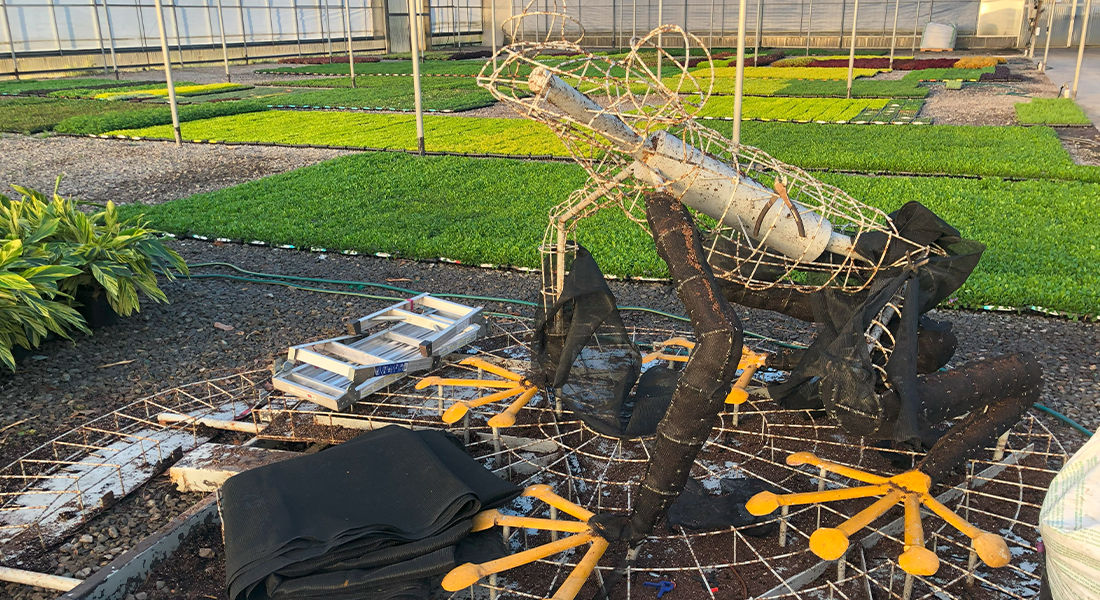Beloved 10th Street Frog Taking Winter Leave of Absence for Replanting
11/02/2023

BY BRIAN CARR
Hold his calls, please. And expect an out-of-office reply to your e-mail. Midtown’s beloved mosaiculture frog sculpture at 10th and West Peachtree Streets, known affectionately by locals as Sam Phibian, is heading out of town next month to take some well-earned time off.
The public art installation was brought to Midtown in 2021 through a partnership between Midtown Alliance and the Atlanta Botanical Garden to create a fun gateway experience into Midtown for people arriving from the district’s western edge. And much work goes into the care and maintenance for this living sculpture.
We touched base with Jim Smith at the Atlanta Botanical Garden to get the scoop on Sam Phibian’s winter respite, and what the team works on daily to keep the frog fresh and green.
First, some glossary help. What is mosaiculture?
Jim Smith is Senior Horticulture Manager at the Atlanta Botanical Garden. He and his team have been working with this unique method of landscape art for a decade.

“Mosaiculture is a form of topiary that essentially creates a mosaic out of plants,” Smith said. “I like to call it topiary for the modern age.”
According to Smith, several features set mosaiculture apart from traditional methods for sculpting plants. Instead of planting into the ground, his team works with 3-D structures - in this case, Sam Phibian’s core is a steel frame - and packs them full of soil to then allow for planting greenery directly into the frame. This allows the installations to be moved around easily.
Mosaiculture also allows for the use of color. So the work product does not just have to be a green bush. Smith and his team use grasses for hairy texture, like the Earth Goddess overlooking the Cascades Garden, which is one of the largest mosaiculture installations at the Garden. They have used yellow plants for Sam Phibian. In fact, Samphibian has appeared in many different colors, from black to yellow to red.
Creative Art Form Borne Out of Conservation Efforts
“We typically model the mosaiculture frogs after real-life frogs,” Smith said about the distinguishing colors of plants.
He explained that the Atlanta Botanical Garden has done significant conservation work for both plants and wildlife. And that the Garden’s amphibian conservation program was part of the origin story for how the mosaiculture frogs arrived here in 2013 via an art show in Montreal.
“We had four species of frogs that we cared for here at the Atlanta Botanical Garden,” Smith said. “And one was the lemur frog that you see out in Midtown.”
Smith added that over time the conservation program has succeeded in reintroducing many of the frog species back into the wild.
It’s not easy being green.
Maintenance on the frog sculpture out at 10th and West Peachtree is a daily assignment for Smith and his team. They work onsite 365 days a year to make sure the plants and soil are watered adequately. And every couple of weeks, the team has to shear and trim the plants on the structure to maintain the shape of the frog’s head, body and appendages.
Now, Sam Phibian is about to go through a major metamorphosis. Smith explained that after three full years of maintenance and growth cycles, the soil inside the structure must be rejuvenated.
“That's about as much as I can ask the soil to give me,” he said. “So the nutrients have been depleted on the inside. We're having to give it more and more fertilizer, more and more input. The soil's not holding water quite as well out there.”
That means rebuilding the frog from the ground up this winter. For Sam Phibian, it’s a trip to the greenhouse to change out the soil, put on new fabric and replant the vegetation. Removal is planned for early December. After replacing the soil, Smith estimates it would take two months for the new plants to grow in. And then the plan is to wait to return the frog sculpture to the island on 10th Street until April 15 to get past what is recognized as Georgia's last frost date for the season.

Public art stokes public curiosity. And that’s a wonderful thing.
Smith shared that his team has fun working on this project because it means so much to the people who encounter it.
“While we are onsite caring for the frog, people who are passing by and see us working are excited to know more about how the sculpture is made,” he said. “Motorists will roll down their windows at the stoplight and they'll have full conversations with us. Working in public horticulture, that's what we're all about here, is educating people. That's the heart of what we do.”
See 50+ public art installations inside a square mile. All within an easy walk. And only in Midtown Atlanta. Our IN*MidtownATL app has it all. Download it now in the Apple and Google Play stores.